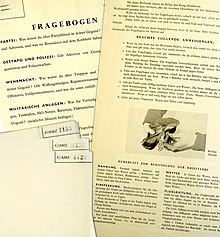November 1944 proposals
In November 1944 the planning group of Operation Periwig had eight scenarios for a hypothetical resistance movement. Groups of people within the Wehrmacht, the party and police, the Catholic Church, industrialists, industrial and mining workers, foreign workers, separatists and members of the Reichsbahn were considered possible resistance fighters.
The Wehrmacht resistance movement was to be assigned its headquarters in Berlin. Gdańsk, Dresden, Hamburg, Nuremberg and other important cities in Germany were chosen as further locations for resistance cells. All cells were to be connected through regular Wehrmacht and personal contact. The office of the Wehrmacht resistance movement in London, under British control, would be in constant contact with the headquarters in Berlin. Two selected German prisoners of war would be able to carry out activities in Germany between the individual cells and communicate with Britain. Other persons employed as agents would maintain regular contact with London. For all other hypothetical resistance movements, similar procedures were worked out that would have been expected from real resistance groups.
To draw attention to the alleged resistance movement in Germany, suitable deceptive measures were devised. Containers with weapons, ammunition, propaganda material, food and the like were to be dropped by aeroplane over supply points of the ostensible resistance movement.


